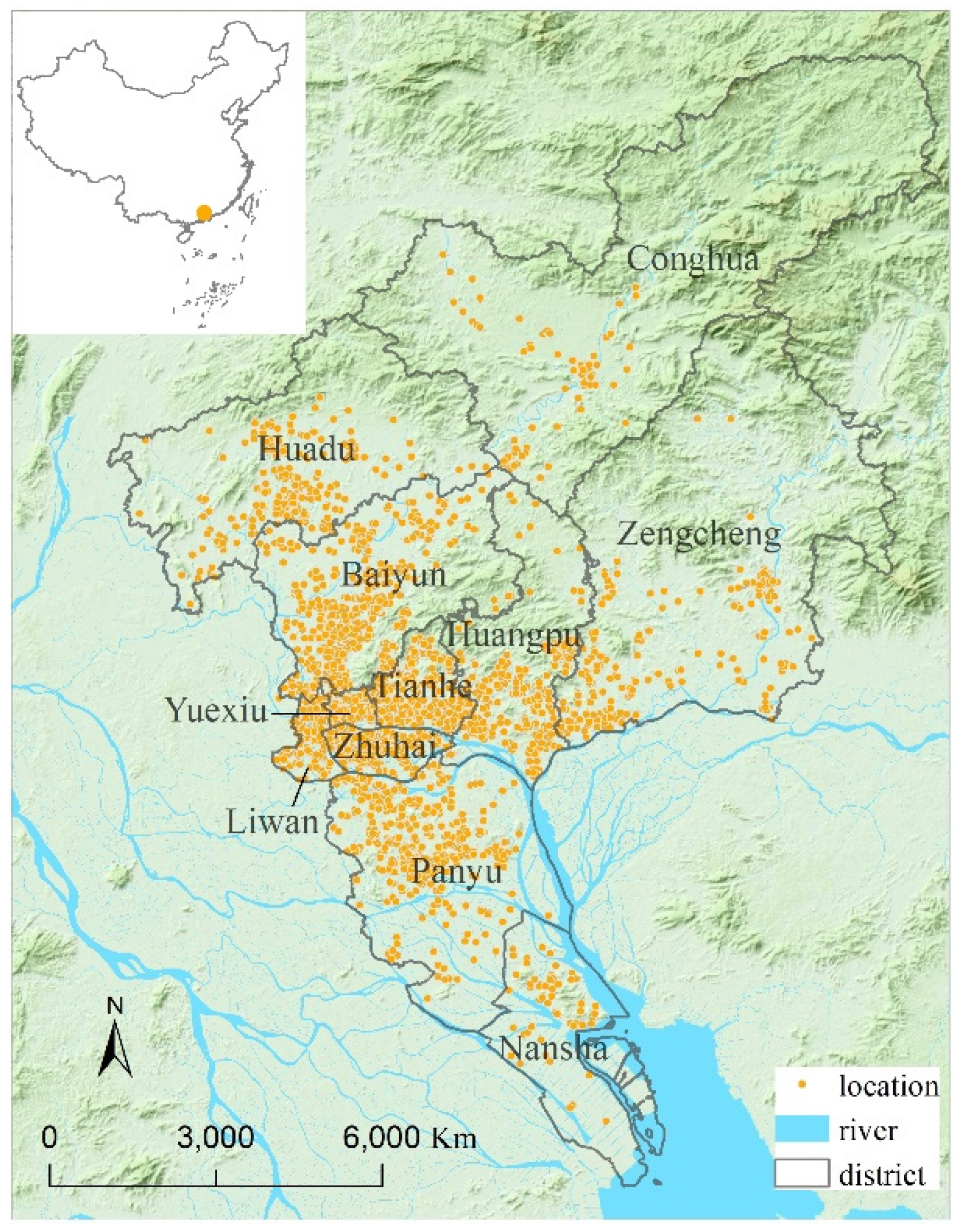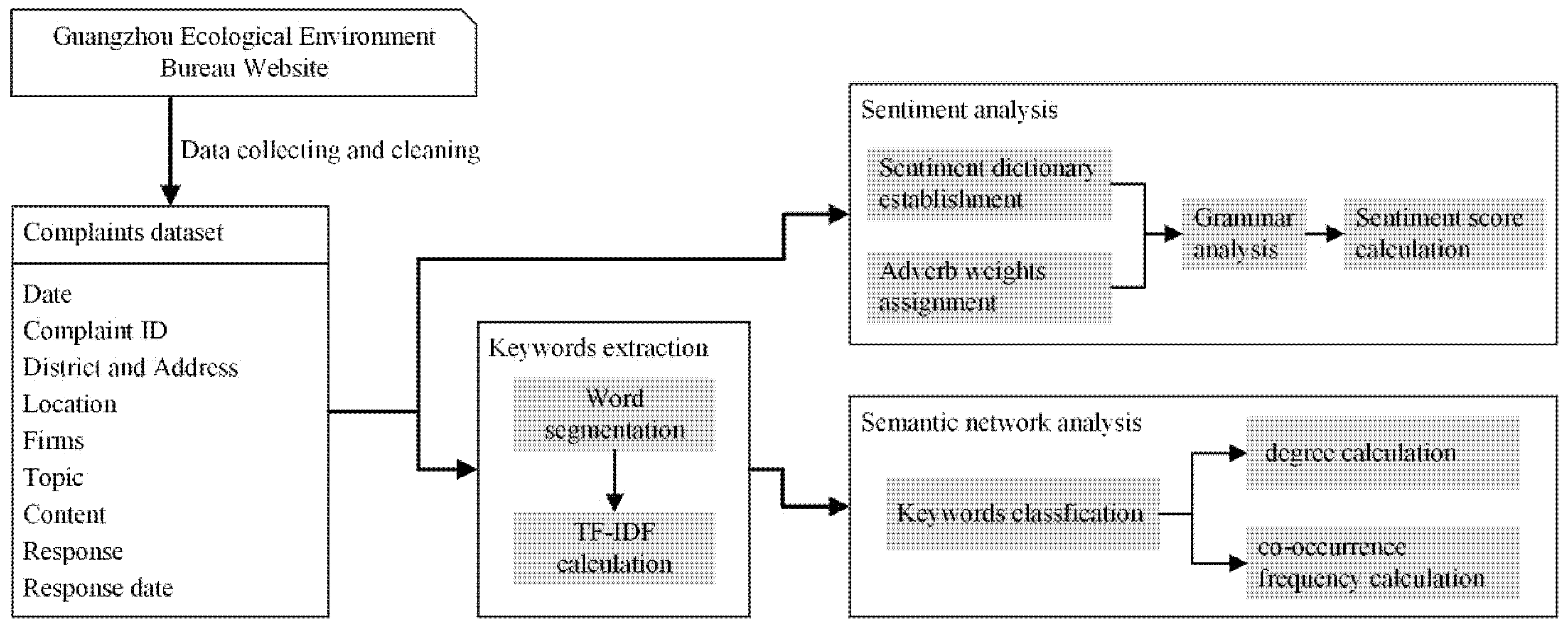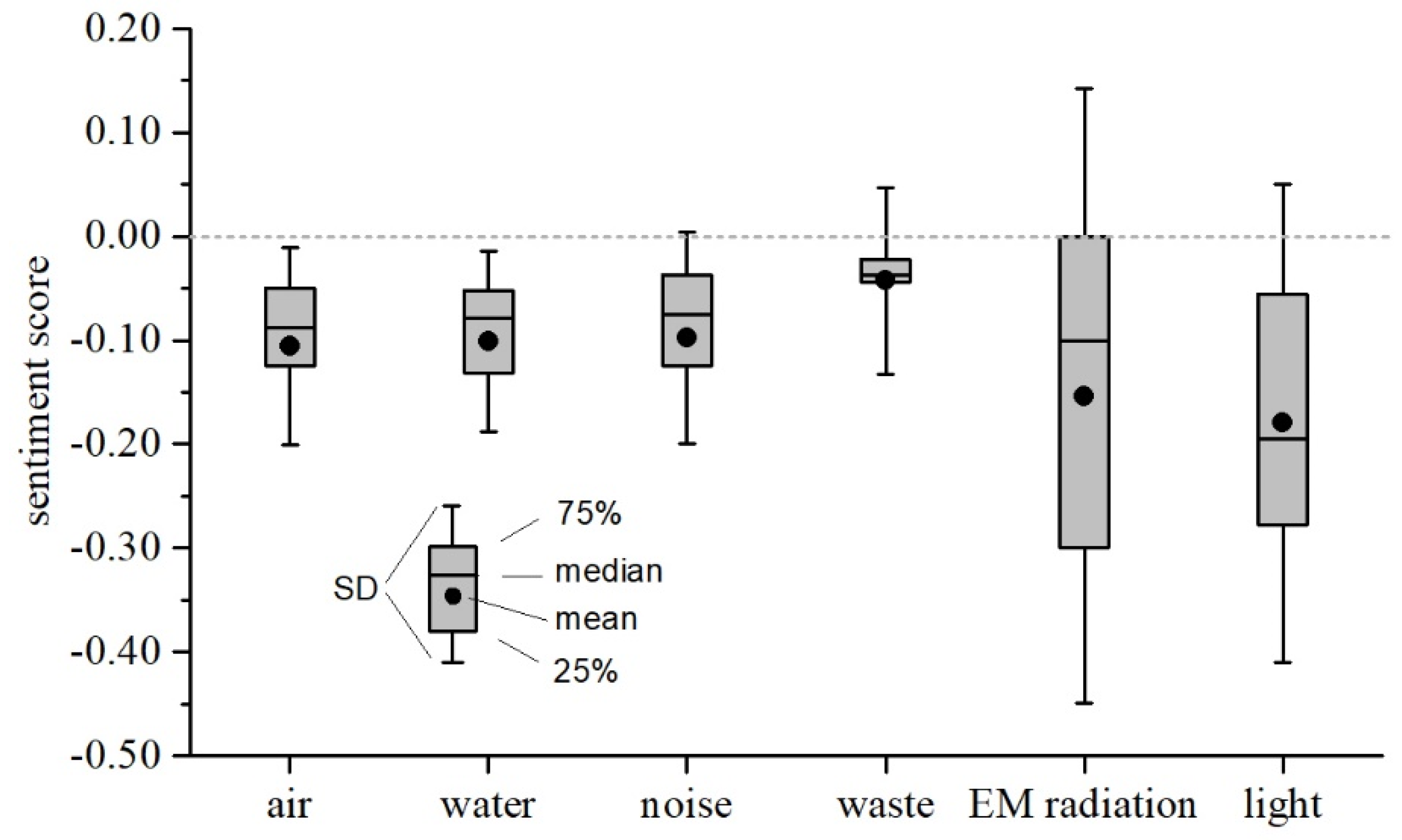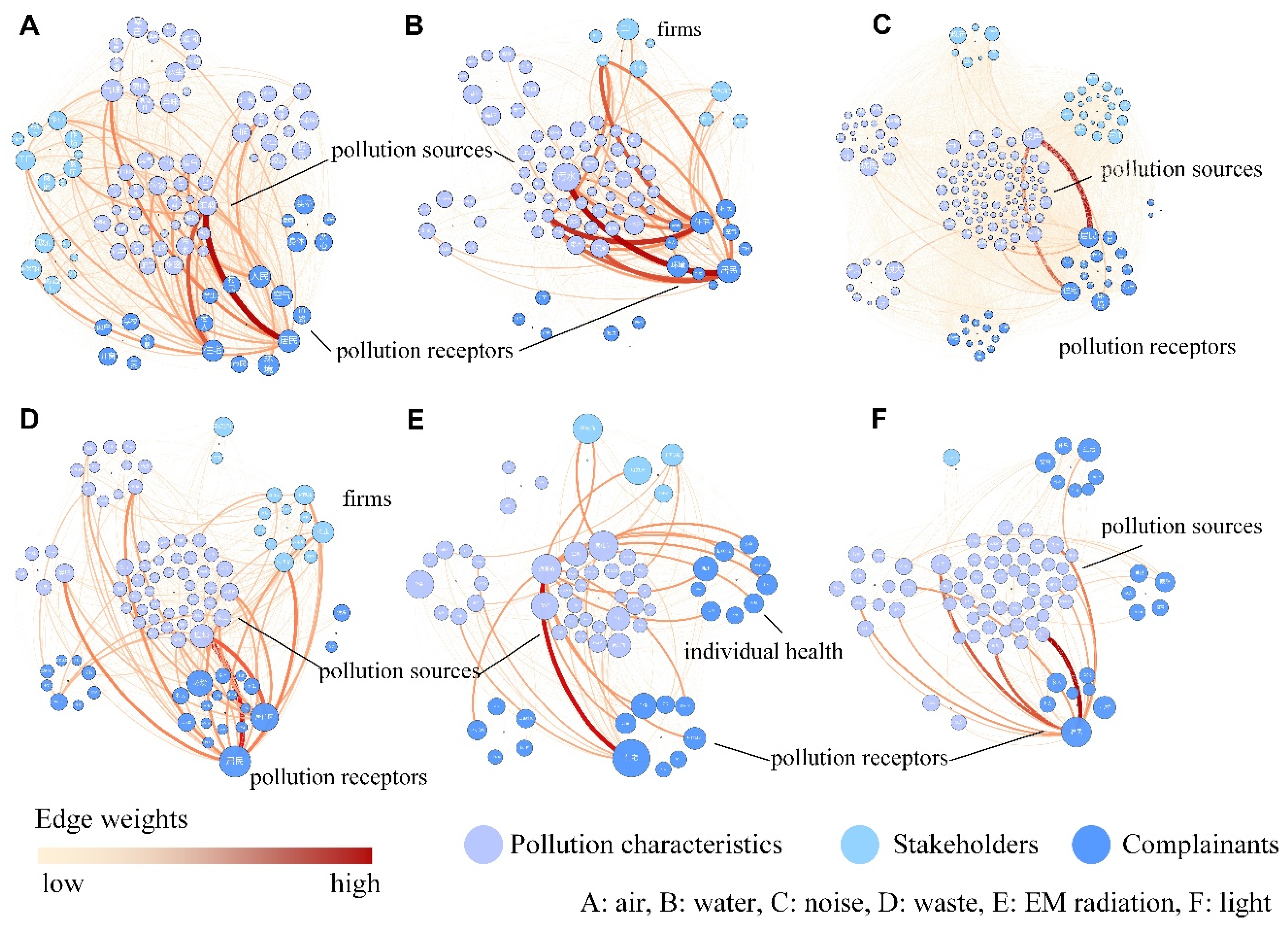Can Urban Environmental Problems Be Accurately Identified? A Complaint Text Mining Method
Abstract
Featured Application
Abstract
1. Introduction
2. Materials and Methods
2.1. Study Area
2.2. Data Collection and Methods
2.2.1. Data Collection and Pre-Processing
2.2.2. Keyword Extraction
2.2.3. Sentiment Analysis
2.2.4. Semantic Network Analysis
3. Results and Discussion
3.1. Keywords of Environmental Complaints
3.2. The Sentiment of Environmental Complaints
3.3. The Semantic Network of Environmental Complaints
4. Conclusions
Author Contributions
Funding
Informed Consent Statement
Conflicts of Interest
References
- Tong, H.; Kang, J. Relationships between noise complaints and socio-economic factors in England. Sustain. Cities Soc. 2021, 65, 102573. [Google Scholar] [CrossRef]
- Zhang, Y.; Chen, M.; Liu, L. A review on text mining. In Proceedings of the 2015 6th IEEE International Conference on Software Engineering and Service Science (ICSESS), Beijing, China, 23–25 September 2015; pp. 681–685. [Google Scholar]
- Dasgupta, S.; Wheeler, D. Citizen Complaints as Environmental Indicators: Evidence from China. In The Causal Effects of Long-Term PM2.5 Exposure on COVID-19 in India; The World Bank: Washington, DC, USA, 1997. [Google Scholar]
- Weersink, A.; Raymond, M. Environmental regulations impact on agricultural spills and citizen complaints. Ecol. Econ. 2007, 60, 654–660. [Google Scholar] [CrossRef]
- Dong, Y.; Ishikawa, M.; Liu, X.; Hamori, S. The determinants of citizen complaints on environmental pollution: An empirical study from China. J. Clean. Prod. 2011, 19, 1306–1314. [Google Scholar] [CrossRef]
- Liu, X.; Dong, Y.; Wang, C.; Shishime, T. Citizen Complaints about Environmental Pollution: A Survey Study in Suzhou, China. J. Curr. Chin. Aff. 2011, 40, 193–219. [Google Scholar] [CrossRef]
- Zhang, X.; Geng, G.; Sun, P. Determinants and implications of citizens’ environmental complaint in China: Integrating theory of planned behavior and norm activation model. J. Clean. Prod. 2017, 166, 148–156. [Google Scholar] [CrossRef]
- Zhang, X.; Liu, J.; Zhao, K. Antecedents of citizens’ environmental complaint intention in China: An empirical study based on norm activation model. Resour. Conserv. Recycl. 2018, 134, 121–128. [Google Scholar] [CrossRef]
- Evendijk, J.; Müskens, P.; De Jong, T. Relationship Between Citizen Complaints of Air Pollution, Meteorological Data and Immission Concentrations. Stud. Environ. Sci. 1980, 8, 379–386. [Google Scholar] [CrossRef]
- Huang, H.; Miller, G.Y. Citizen Complaints, Regulatory Violations, and Their Implications for Swine Operations in Illinois. Appl. Econ. Perspect. Policy 2006, 28, 89–110. [Google Scholar] [CrossRef]
- Carvalho, D.S.; Fidélis, T. The perception of environmental quality in Aveiro, Portugal: A study of complaints on environmental issues submitted to the City Council. Local Environ. 2009, 14, 939–961. [Google Scholar] [CrossRef]
- Wang, H.; Di, W. The Determinants of Government Environmental Performance: An Empirical Analysis of Chinese Townships. In The Causal Effects of Long-Term PM2.5 Exposure on COVID-19 in India; The World Bank: Washington, DC, USA, 2002; pp. 704–708. [Google Scholar]
- Arshad, S.; Shafqat, A.; Khan, A.A.; Safdar, Q. Youth environmental complaints in Bahawalpur City, Pakistan: An informational intervention for local environmental governance. Hum. Geogr. J. Stud. Res. Hum. Geogr. 2013, 7, 71–80. [Google Scholar] [CrossRef]
- Zhang, G.; Deng, N.; Mou, H.; Zhang, Z.G.; Chen, X. The impact of the policy and behavior of public participation on environmental governance performance: Empirical analysis based on provincial panel data in China. Energy Policy 2019, 129, 1347–1354. [Google Scholar] [CrossRef]
- Bhasuran, B.; Subramanian, D.; Natarajan, J. Text mining and network analysis to find functional associations of genes in high altitude diseases. Comput. Biol. Chem. 2018, 75, 101–110. [Google Scholar] [CrossRef]
- Jacinto, R.; Reis, E.; Ferrão, J. Indicators for the assessment of social resilience in flood-affected communities—A text mining-based methodology. Sci. Total Environ. 2020, 744, 140973. [Google Scholar] [CrossRef]
- Tseng, Y.H.; Ho, Z.P.; Yang, K.S.; Chen, C.C. Mining term networks from text collections for crime investigation. Expert Syst. Appl. 2012, 39, 10082–10090. [Google Scholar] [CrossRef]
- Liu, P.; Zhang, L.; Gulla, J.A. Multilingual Review-aware Deep Recommender System via Aspect-based Sentiment Analysis. ACM Trans. Inf. Syst. 2021, 39, 1–33. [Google Scholar] [CrossRef]
- Min, K.; Jun, B.; Lee, J.; Kim, H.; Furuya, K. Analysis of Environmental Issues with an Application of Civil Complaints: The Case of Shiheung City, Republic of Korea. Int. J. Environ. Res. Public Health 2019, 16, 1018. [Google Scholar] [CrossRef]
- Lee, E.; Lee, S.; Kim, K.S.; Pham, V.H.; Sul, J. Analysis of Public Complaints to Identify Priority Policy Areas: Evidence from a Satellite City around Seoul. Sustainability 2019, 11, 6140. [Google Scholar] [CrossRef]
- Lee, J.-H.; Park, H.-J.; Kim, I.; Kwon, H.-S. Analysis of cultural ecosystem services using text mining of residents’ opinions. Ecol. Indic. 2020, 115, 106368. [Google Scholar] [CrossRef]
- Salton, G.; Buckley, C. Term-weighting approaches in automatic text retrieval. Inf. Process. Manag. 1988, 24, 513–523. [Google Scholar] [CrossRef]
- Xin, Y.; Yang, Y.; Jiao, W.; Zhu, D.; Zheng, S.; Yuan, Z.; Yang, X.; Luo, Z. Sentiment Analysis of Homestay Comments Based on Domain Dictionary. Sci. Technol. Eng. 2020, 020, 2794–2800. [Google Scholar]
- Opsahl, T. Triadic closure in two-mode networks: Redefining the global and local clustering coefficients. Soc. Netw. 2013, 35, 159–167. [Google Scholar] [CrossRef]
- Bastian, M.; Heymann, S.; Jacomy, M. Gephi: An Open Source Software for Exploring and Manipulating Networks. In Proceedings of the Third International Conference on Weblogs and Social Media, San Jose, CA, USA, 17–20 May 2009. [Google Scholar]





| Date | 29 November 2018 13:03:15 |
| Complaint ID | 201811291303154988337 |
| District | 黄埔区 Huangpu district |
| Address | 广州经济技术开发区永和经济区田园路西南 Guangzhou Economic and Technological Development Zone, Yonghe Economic Zone Southwest of Tianyuan Road |
| Firms | 广州诺金制药有限公司 Guangzhou Nuojin Pharmaceutical Co., Ltd. |
| Topic | 空气污染 Air pollution |
| Content | 药厂排放废气,严重影响周边环境。 The waste gas emitted by the pharmaceutical factory seriously affects the surrounding environment. |
| Response | 接到投诉后,黄埔区环保局于2018年12月29日到广州诺金制药有限公司现场检查。经查,该公司主要生产中成药,环保手续齐全,在药材炒制、粉碎产生少量粉尘废气和清洗中药废水产生;现场检查时,该公司产生废气经吸尘器处理后高空排放,没有闻到异味。1月25日电话联系投诉人,投诉人表示满意。 After receiving the complaint, the Huangpu District Environmental Protection Bureau conducted an on–site inspection on December 29, 2018. After investigation, the company mainly produces Chinese patent medicines with complete environmental protection procedures. A small amount of dust and waste gas generated during the frying and crushing of medicinal materials and waste water from cleaning Chinese medicine were produced. During on–site inspection, the company’s waste gas was discharged at high altitude after being treated by a vacuum cleaner, and no peculiar smell was smelled. The complainant was contacted by telephone on January 25, and the complainant expressed satisfaction. |
| Response date | 28 January 2019 15:31:25 |
| No. | District | Air | Water | Noise | Waste | EM Radiation | Light | Total |
|---|---|---|---|---|---|---|---|---|
| 1 | Conghua | 83 | 16 | 54 | 4 | 0 | 0 | 157 |
| 2 | Nansha | 113 | 22 | 47 | 9 | 0 | 1 | 192 |
| 3 | Yuexiu | 113 | 8 | 98 | 13 | 3 | 3 | 238 |
| 4 | Liwan | 182 | 33 | 108 | 12 | 3 | 1 | 339 |
| 5 | Zengcheng | 254 | 42 | 87 | 4 | 7 | 1 | 395 |
| 6 | Haizhu | 252 | 34 | 249 | 12 | 0 | 8 | 555 |
| 7 | Huadu | 382 | 54 | 131 | 16 | 4 | 1 | 588 |
| 8 | Huangpu | 388 | 19 | 223 | 8 | 0 | 5 | 643 |
| 9 | Tianhe | 313 | 39 | 309 | 15 | 0 | 4 | 680 |
| 10 | Panyu | 402 | 63 | 230 | 14 | 4 | 0 | 713 |
| 11 | Baiyun | 594 | 127 | 422 | 22 | 5 | 2 | 1172 |
| Total | 3076 | 457 | 1958 | 129 | 26 | 26 | 5672 |
| Lexicon | Examples of Sentiment Words | Emotion | Weight |
|---|---|---|---|
| General | 开心 (happy), 公平 (fair), 心爱 (beloved) | Positive | 1 |
| 不幸 (unfortunate), 狂怒 (furious), 狠心 (heartless) | Negative | −1 | |
| Domain | 安全 (safety), 干净 (clean), 舒服 (comfortable) | Positive | 1 |
| 危害 (harmful), 刺激 (irritation), 刺耳 (piercing) | Negative | −1 |
| Level | Examples of Adverb (A) and Inverse Words (N) | Weight (Aw) |
|---|---|---|
| Most | 超级 (super), 极其 (extremely), 最 (most) | 3 |
| Very | 特别 (special), 非常 (very), 尤其 (especially) | 2.1 |
| More | 更 (more), 较 (relatively), 越是 (more) | 1.5 |
| Ish | 略微 (slightly), 一些 (some), 有点 (a little) | 1.06 |
| Insufficiently | 仅仅 (merely), 不太 (not too), 相对 (relative) | 0.75 |
| Over | 不为过 (not too much), 略多 (slightly more) | 0.53 |
| No. | Combination | Example | Score | |
|---|---|---|---|---|
| 1 | S | 开心 (happy) | Sp | 1 |
| 2 | S + !/? | 开心! (happy!/happy?) | Sp + 2/−2 | 3/−1 |
| 3 | N + S | 不开心 (not happy) | (−1) × Sp | −1 |
| 4 | N + N + S | 不是不开心 (not unhappy) | Sp | 1 |
| 5 | N + A + S | 不是非常开心 (not very happy) | 0.5 × Aw × Sp | 1.1 |
| 6 | A + S | 非常开心 (very happy) | Aw × Sp | 2.1 |
| 7 | A +A + S | 非常非常开心 (very, very happy) | (Aw + Aw) × Sp | 4.2 |
| 8 | A + N + S | 非常不高兴 (very unhappy) | 1.5 × (−1) × Aw × Sp | −3.15 |
| 9 | S + A | 危害极大 (extremely harmful) | Aw × Sn | −3 |
| Air | Water | Noise | Waste | EM Radiation | Light | ||||||||||||
|---|---|---|---|---|---|---|---|---|---|---|---|---|---|---|---|---|---|
| Keyword | TF–IDF | Keyword | TF–IDF | Keyword | TF–IDF | Keyword | TF–IDF | Keyword | TF–IDF | Keyword | TF–IDF | ||||||
| 居民 | resident | 149.75 | 污水 | sewage | 33.50 | 噪音 | noise | 180.32 | 垃圾 | waste | 13.54 | 换流站 | converter station | 2.94 | 小区 | community | 2.26 |
| 油烟 | lampblack | 138.85 | 居民 | resident | 19.55 | 居民 | resident | 109.49 | 清理 | clean up | 7.23 | 项目 | project | 2.82 | 居民 | resident | 2.16 |
| 废气 | exhaust | 122.62 | 恶臭 | stench | 12.52 | 扰民 | disturb | 87.16 | 小区 | community | 6.46 | 信号 | signal | 2.72 | 外墙 | exterior wall | 1.79 |
| 气味 | odor | 120.87 | 工厂 | factory | 11.79 | 声音 | sound | 52.09 | 居民 | resident | 5.72 | 基站 | base station | 2.69 | 严重 | serious | 1.66 |
| 工厂 | factory | 97.01 | 环境 | surrounding | 11.70 | 小区 | community | 47.80 | 环境 | surrounding | 5.63 | 居民 | resident | 2.19 | 通宵 | overnight | 1.54 |
| 小区 | community | 94.48 | 村民 | villager | 11.67 | 分贝 | decibel | 44.72 | 建筑 | building | 5.51 | 电磁辐射 | electromagnetic radiation | 1.88 | 射灯 | spotlight | 1.49 |
| 部门 | department | 82.03 | 部门 | department | 11.10 | 部门 | department | 44.40 | 垃圾桶 | ashbin | 5.21 | 规划 | planning | 1.84 | 强光 | glare | 1.35 |
| 健康 | health | 79.79 | 下水道 | sewer | 11.07 | 噪声 | noise | 44.17 | 村民 | villager | 4.68 | 楼顶 | roof | 1.80 | 广告牌 | billboard | 1.15 |
| 味道 | smell | 78.99 | 气味 | odor | 9.83 | 油烟 | lampblack | 42.63 | 部门 | department | 4.51 | 屋主 | homeowner | 1.79 | 扰民 | disturb | 1.09 |
| 垃圾 | waste | 75.79 | 废气 | exhaust | 9.77 | 粉尘 | dust | 37.97 | 土壤 | soil | 4.29 | 距离 | distance | 1.62 | 平台 | platform | 1.06 |
| Cluster | Sub–Cluster | Air | Water | Noise | Waste | EMR | Light |
|---|---|---|---|---|---|---|---|
| 1. Pollution characteristic | Pollution source (PS) | 29.17% | 49.45% | 49.15% | 38.62% | 38.03% | 54.65% |
| Pollution behavior (PB), | 13.54% | 8.79% | 11.32% | 11.88% | 14.08% | 13.95% | |
| sensory features (SF) | 15.62% | 10.99% | 5.65% | 5.94% | 5.63% | 3.49% | |
| 2. Stakeholder | Firms (FM), | 10.42% | 6.59% | 11.86% | 11.88% | 2.82% | 2.33% |
| administration (AD) | 7.29% | 4.39% | 4.52% | 2.97% | 5.63% | 0 | |
| 3. Complainant | Pollution receptor (PR), | 11.46% | 12.09% | 8.47% | 16.83% | 9.86% | 9.3% |
| social life (SL), | 6.25% | 4.4% | 7.34% | 8.91% | 11.27% | 9.3% | |
| individual health (HL) | 6.25% | 3.3% | 1.69% | 2.97% | 12.68% | 6.98% |
| Air | Water | Noise | ||||||
| Relation | Edge | Weight | Relation | Edge | Weight | Relation | Edge | Weight |
| PR–PS | 居民–油烟 resident–lampblack | 1196 | PR–PS | 居民–污水resident–sewage | 114 | PS–PR | 噪声–居民noise–resident | 1255 |
| PR–PS | 住宅–油烟residential–lampblack | 849 | PR–PS | 住宅–油池residential–oil bath | 100 | PR–PS | 住宅–噪声residential–noise | 868 |
| PR–SF | 居民–气味resident–smell | 647 | PR–PS | 居民–河流resident–river | 83 | PR–PS | 居民–油烟resident–lampblack | 456 |
| PR–PS | 居民–废气resident–exhaust gas | 596 | PR–FM | 住宅–商场residential–mall | 80 | PR–PS | 住宅–油烟residential– lampblack | 422 |
| PR–PS | 人民–垃圾people–waste | 512 | PR–PS | 居民–油池resident–oil bath | 79 | PS–PR | 噪声–环境noise-environment | 339 |
| PR–PS | 住宅–废气residential–exhaust gas | 507 | PR–PS | 住宅–垃圾residential–waste | 71 | PB–PR | 很大–居民very noisy-resident | 268 |
| PR–AD | 居民–环保局resident–Environmental Protection Agency | 483 | PR–PS | 住宅–污水residential–sewage | 66 | PR–PB | 居民–扰民resident–disturb | 253 |
| PR–PB | 人民–选址people–location | 480 | FM–PR | 商场–居民mall–resident | 64 | PS–PS | 噪声–道路noise–road | 243 |
| PR–PS | 住宅–垃圾residential–waste | 478 | PR–PS | 住宅–广场residential–square | 60 | PS–AD | 噪声–政府noise–government | 200 |
| PR–SF | 住宅–气味residential–smell | 444 | FM–PS | 商场–油池mall–oil bath | 60 | PR–PB | 住宅–扰民residential–disturb | 194 |
| Waste | EM radiation | Light | ||||||
| Relation | Edge | Weight | Relation | Edge | Weight | Relation | Edge | Weight |
| PS–PR | 垃圾–居民waste–resident | 55 | PR–PS | 住宅–换流站residential-converter station | 64 | PS–PR | LED–居民LED–resident | 17 |
| PS–PR | 垃圾–住宅waste–residential | 38 | PS–FM | 变电站–开发商substation-developer | 32 | PR–PS | 居民–灯光resident–light | 12 |
| PS–PR | 垃圾站–居民garbage station–resident | 31 | PS–HL | 变电站–安全substation-safety | 32 | PR–PS | 居民–楼盘resident–real estate | 12 |
| PR–SF | 居民–臭味resident–stench | 30 | PS–HL | 换流站–身心健康converter station-physical and mental health | 31 | PB–PR | 刺眼–居民glare-resident | 10 |
| PR–PB | 居民–选址resident–location | 28 | HL–PS | 健康–换流站health-converter station | 29 | PB–PR | 光污染–居民light pollution-resident | 8 |
| PR–PS | 居民–蚊虫resident–mosquito | 25 | PR–PS | 居住环境–换流站living environment-converter station | 29 | PR–PB | 居民–施工resident-construction | 8 |
| PS–PR | 垃圾–环境waste- environment | 25 | PR–PS | 儿童–换流站children-converter station | 28 | PR–PB | 居民–通宵resident- overnight | 7 |
| PS–PR | 垃圾桶–住宅ashbin–residential | 25 | PS–AD | 换流站–电力局converter station-power bureau | 28 | PS–PR | 射灯–居民spotlights-resident | 7 |
| PR–PS | 住宅–蚊虫residential–mosquito | 23 | PS–PR | 换流站–聚居区converter station-residential area | 28 | PS–PR | 噪音–居民noise–resident | 6 |
| PR–FM | 居民–物业resident–property | 22 | PS–HL | 换流站–死亡率converter station-mortality rate | 28 | PS–SL | 平台–生活platform-life | 6 |
Publisher’s Note: MDPI stays neutral with regard to jurisdictional claims in published maps and institutional affiliations. |
© 2021 by the authors. Licensee MDPI, Basel, Switzerland. This article is an open access article distributed under the terms and conditions of the Creative Commons Attribution (CC BY) license (https://creativecommons.org/licenses/by/4.0/).
Share and Cite
Jiao, Y.; Li, C.; Lin, Y. Can Urban Environmental Problems Be Accurately Identified? A Complaint Text Mining Method. Appl. Sci. 2021, 11, 4087. https://doi.org/10.3390/app11094087
Jiao Y, Li C, Lin Y. Can Urban Environmental Problems Be Accurately Identified? A Complaint Text Mining Method. Applied Sciences. 2021; 11(9):4087. https://doi.org/10.3390/app11094087
Chicago/Turabian StyleJiao, Yaran, Chunming Li, and Yinglun Lin. 2021. "Can Urban Environmental Problems Be Accurately Identified? A Complaint Text Mining Method" Applied Sciences 11, no. 9: 4087. https://doi.org/10.3390/app11094087
APA StyleJiao, Y., Li, C., & Lin, Y. (2021). Can Urban Environmental Problems Be Accurately Identified? A Complaint Text Mining Method. Applied Sciences, 11(9), 4087. https://doi.org/10.3390/app11094087






